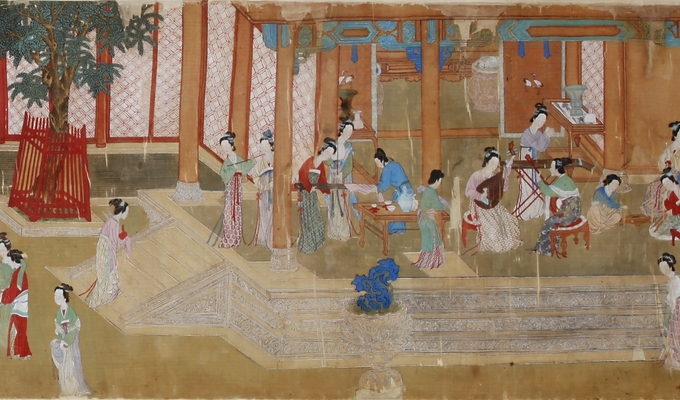The Asian sub-collection gathers items from Asia, the Islamic Middle East, Central Asia, the Caucasus, India, Southeast Asia, Vietnam, Indonesia, Tibet, China, Mongolia, Korea and Japan. The oldest acquisitions came in the 19th century, mostly from friends of the museum’s founder, Vojta Náprstek. In the late 19th century, there were already large collections from travellers, collectors and experts such as doctors and officials who had the chance to spend some time in Asian countries. In the first half of the 20th century, there were significant additions in the form of private collections of artists and scientists that were greatly interested in Asian cultures. To this day, the sub-collection is being extended with new acquisitions. The Asian sub-collection consists of objects dating from Antiquity to the present day, including not only archaeological and ethnographic material, but also arts and crafts objects such as paintings. The sub-collection is divided by geographic region. The items from the Middle East, Central Asia and the Caucasus were acquired by the Náprstek Museum in the 19th century, most of the remainder coming in the post-war period. These items are in particular arts and crafts objects, weapons, textiles, ceramics and porcelain. The Indian collection contains items from India, Pakistan, Nepal, Bhutan and Sri Lanka. The collection holds valuable works in metal, paintings and sculptures from the 1st millennium CE. The influence of Indian art is reflected in the art of neighbouring Burma and the other countries of Southeast Asia – Thailand, Cambodia, Laos and Indonesia. These countries are represented by a relatively small but characteristic collection of items. Vietnam is represented by the set of anonymous prints collected in the second half of the 20th century. The Náprstek Museum’s Indonesian collection had already begun to form in Vojta Náprstek’s lifetime. It contains samples from tribal cultures and traditional crafts. The items from China date from Antiquity to the present. The majority of them, however, originate in the 18th and 19th centuries. They include mostly arts and crafts objects, weapons, textiles, porcelain and paintings. The Lamaism collection includes mainly religious objects of Northern Buddhism from Tibet, Mongolia and China. The Korean collection is relatively small. It contains primarily textiles, but also samples of traditional pottery and porcelain. The Japanese collection is the largest comprehensive collection in the Náprstek Museum, numbering over 20,000 items, from objects of everyday use to excellent examples of the arts and crafts.
Related collections
- Asian Cultures Collection – China The Chinese collection encompasses the period from the Neolithic to the present. However, the majority of items originate in the 18th and 19th centuries. The collection represents mostly artisan crafts, paintings, pottery, porcelain and textiles.
- Asian Cultures Collection – India The Indian collection contains items from India, Pakistan, Nepal, Bhutan and Sri Lanka. The first items came to the National Museum as early as the 19th century. The collection includes valuable works in metal, paintings and also sculptures.
- Asian Cultures Collection – Indonesia The Náprstek Museum’s Indonesian collection began to form in Vojta Náprstek’s lifetime. The notable collectors associated with this collection are the Czech physicians František Czurda (1844–1886) and Pavel Durdík (1843–1903), who in the 1870s and 1880s worked on the islands of Celebes, Sumatra and Nias.
- Asian Cultures Collection – Japan The collection of Japanese art, crafts and ethnographic material is the largest comprehensive collection in the Náprstek Museum, and currently it numbers 22,000 exhibits.
- Asian Cultures Collection – Korea The Korean collection of the Náprstek Museum is one of the smallest Asian collections. Korean arts and crafts are represented very unevenly here.
- Asian Cultures Collection – Lamaism The items in the Lamaism collection come from Tibet, China and Mongolia. They include religious paintings, bronze sculptures of deities and ritual objects.
- Asian Cultures Collection – the Middle East, Central Asia and the Caucasus The items from the Middle East, Central Asia and the Caucasus were acquired by the Náprstek Museum in the 19th century, most of the remainder coming in the post-war period. These are in particular artisan craft, weapons, textiles, pottery and porcelain.
- Asian Cultures Collection – Vietnam The Vietnam collection is not large. It has mostly been put together in recent decades. It contains mostly colour woodcuts, ceramics and textiles.
- Asian Cultures Collection – South East Asia The influence of Indian art is reflected in the art of neighbouring Burma and other countries of Southeast Asia – Thailand, Cambodia, Laos and Indonesia. These countries are represented by a relatively small collection. The earliest acquisitions came in the 19th century.

